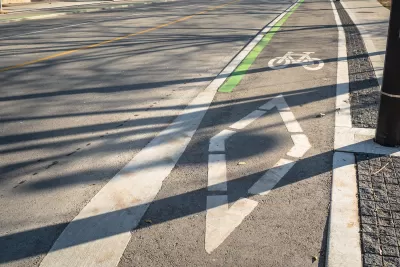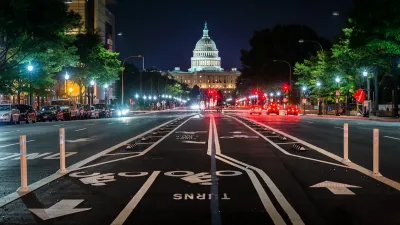Some cities are going so far as to rip out protected bike infrastructure that took years of advocacy to build.

“The trend to remove bike lanes is growing, and it is scary, and based in an imaginary world where the only thing that exists is a car and its suburban driver,” writes Ron Johnson in Momentum, drawing attention to a troubling trend that is seeing city officials in U.S. and Canadian cities removing hard-won bike infrastructure.
At the federal level in the United States, President Trump has expressed disdain for bike lanes and a desire to kill New York City’s congestion program (along with its bike infrastructure). But the trend began before his election, with cities like Ontario and San Mateo moving to destroy existing bike infrastructure.
It’s one thing to remove a painted bike lane, which offered little protection anyway. But, to invest the resources to actually remove safe and separated bike lanes that take planning, and millions of dollars of investment, is so non-sensical it’s always comedic if it weren’t so tragic.
For Johnson, part of the problem stems from the lack of long-term vision and commitment to cycling infrastructure. “A real bike network isn’t just a few painted lines or token bike boulevards. It’s a commitment to creating a connected, protected network that spans an entire city—one that allows cyclists to get from point A to point B without dodging traffic, worrying about unsafe intersections, or feeling like an afterthought in a car-dominated city.”
People who want to see bike infrastructure continue to grow must, in Johnson’s view, advocate loudly for it against the tide of opposition. “It won’t be easy, but it’s crucial that we continue to push for safe, accessible, and well-connected bike networks in our cities.”
FULL STORY: Cities Start to Backpedal on Bike Lanes: A Growing Crisis for Cyclists

Alabama: Trump Terminates Settlements for Black Communities Harmed By Raw Sewage
Trump deemed the landmark civil rights agreement “illegal DEI and environmental justice policy.”

Study: Maui’s Plan to Convert Vacation Rentals to Long-Term Housing Could Cause Nearly $1 Billion Economic Loss
The plan would reduce visitor accommodation by 25% resulting in 1,900 jobs lost.

Why Should We Subsidize Public Transportation?
Many public transit agencies face financial stress due to rising costs, declining fare revenue, and declining subsidies. Transit advocates must provide a strong business case for increasing public transit funding.

Paris Bike Boom Leads to Steep Drop in Air Pollution
The French city’s air quality has improved dramatically in the past 20 years, coinciding with a growth in cycling.

Why Housing Costs More to Build in California Than in Texas
Hard costs like labor and materials combined with ‘soft’ costs such as permitting make building in the San Francisco Bay Area almost three times as costly as in Texas cities.

San Diego County Sees a Rise in Urban Coyotes
San Diego County experiences a rise in urban coyotes, as sightings become prevalent throughout its urban neighbourhoods and surrounding areas.
Urban Design for Planners 1: Software Tools
This six-course series explores essential urban design concepts using open source software and equips planners with the tools they need to participate fully in the urban design process.
Planning for Universal Design
Learn the tools for implementing Universal Design in planning regulations.
Smith Gee Studio
Alamo Area Metropolitan Planning Organization
City of Santa Clarita
Institute for Housing and Urban Development Studies (IHS)
City of Grandview
Harvard GSD Executive Education
Toledo-Lucas County Plan Commissions
Salt Lake City
NYU Wagner Graduate School of Public Service





























